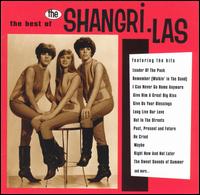 The Shangri-La's I like to think of a situation wherein some proverbial "extraterrestrial beings" come down to Earth and take this CD as a reflection of "Earth culture" and decide to build an entirely new civilization around it. This wonderful new world would be filled with tough girls and their tougher boyfriends, unrelenting authoritarian parents and judgmental peers, motorcycles and shades – social concourse would consist of furtive meetings away from "the world," which can never understand true love. What a beautifully dramatic world that would be. Until I can tap into whatever alternate reality will allow me to experience this world, I will have to be content with The Best of the Shangri-La's, a definitive collection from the greatest girl group of them all … these chicks could kick the Supremes' bony asses, and would do it, too, if they put down the Shangri-La's boyfriends. The Shangri-La's were Mary Weiss and her sister Liz (who was only with the group fleetingly), backed by twins Marge and Maryann Ganser, singing true "teenage symphonies to God" produced by Shadow Morton, who, for my money, far eclipses Phil Spector for pure viscerality. Best known for the great "Leader of the Pack," which is too often dismissed as a novelty song, the Shangri-La's actually recorded a wealth of amazing material that explores this sordid teenage soap opera lifestyle to even better effect. "Leader of the Pack" was justifiably a hit – you can't beat a song in which the singer's boyfriend is killed in a motorcycle accident, replete with horrible sound effects that depict the brutal event, while her friends sing funereally in the background. It's hard to think of any group more consistently off-the-wall yet as supremely satisfying, but song after song delivers a masterful punch right in the teenage heart of every listener. Better even that "Leader" are the lesser hits, probably a bit too intense for typical 60s pop radio: "Remember (Walkin' in the Sand)," a desperate rumination on lost love that is more depressing than your average Cure song, but with more seagull sounds. "Give Him a Great Big Kiss" is a song I could listen to for hours – and I have – every detail is wonderful candy, from the rock solid drumming bouncing off the handclaps and footstomps, to the kooky, deep brass lines that punctuate the pre-chorus, up through Mary Weiss's infectious vocal ("He's good bad, but he's not evil") and the riotous ending ("What do you mean, is he a good dancer?" "Well, how does he dance?" "Close … veryclose"). "Out in the Streets," in which Mary actually has to break up with her boyfriend because he used to be a bad boy, but has cleaned up his act since becoming her boyfriend – and she knows he's really a bad boy at heart, and doesn't want to stand in her way! "Sophisticated Boom Boom," in which the girl gets stood up, but finds herself in a jazz club where she enjoys the new sounds. "Give Us Your Blessings," in which the unsanctioned young couple elopes, only to die in a car accident, leaving their families racked with guilt. All of these psychotic little dramas are played out to great girl-group chords, drenched in reverb, and put across with 100% conviction by Weiss and company. Unlike most girl-group pop, these songs stand up to tons of repeat listens, and reveal layer after layer of detail. As the disc progresses, the songs get more arty, pushing the boundaries of pop with increasingly dark subject matter and manipulative arrangements full of melodramatic strings – but even the weirdest moments don't really come off as stupid or cheesy – rather, incredibly cool in ways that you don't normally find in pop, especially "oldies" pop. The group's maturity over only three years (1964-67) is as impressive as any 60's group including your beloved Beatles – up to the almost terrifying singles "I Can Never Go Home Anymore" and the particularly touchy "Past, Present and Future" (one of the only pop songs to deal with rape in a realistic way, with the exception of most Kiss songs). The disc reaches its peak with the amazing "I'll Never Learn," which sounds sort of like Elvis Costello or Björk with the Brodsky Quartet … but easily better than either. Simply astounding music, all the more so because you're so surprised that it's by the group that did "Leader of the Pack." The disc closes with the sadly neglected "Footsteps on the Roof," another gem that is as good or better than any of the Brian Wilson or Beatles material that is consistently held up to be the best pop of the era. The Best of the Shangri-La's, at 25 tracks and almost 70 minutes, has its share of more forgettable moments, but the peaks are so high it only makes the valleys look prettier by contrast. This is amazing, original, gorgeous, emotionally charged music by one of the more unsung bands of the 60s. Arguably, the Shangri-La's are among the two or three most influential groups of the 60s, but you see the influence crop up in places where it isn't immediately obvious – Blondie and Hole, for example, so the legacy has not been entirely in the drag community. Too bad mine has!
Review by Wimpempy Tarlisle |
